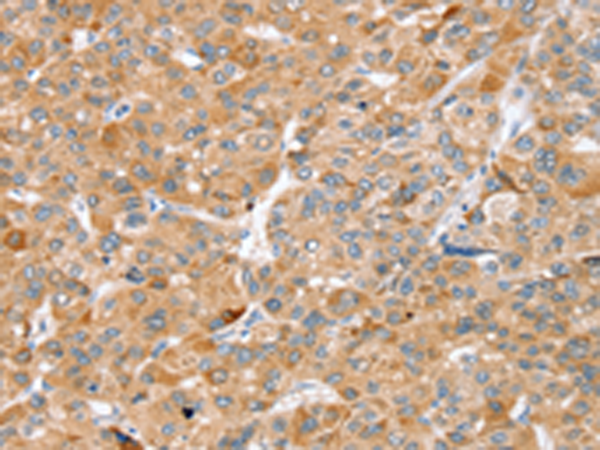

| WB | 咨询技术 | Human,Mouse,Rat |
| IF | 咨询技术 | Human,Mouse,Rat |
| IHC | 1/25-1/100 | Human,Mouse,Rat |
| ICC | 技术咨询 | Human,Mouse,Rat |
| FCM | 咨询技术 | Human,Mouse,Rat |
| Elisa | 1/1000-1/2000 | Human,Mouse,Rat |
| Aliases | BRF2; ERF2; ERF-2; TIS11D; RNF162C |
| WB Predicted band size | 51 kDa |
| Host/Isotype | Rabbit IgG |
| Antibody Type | Primary antibody |
| Storage | Store at 4°C short term. Aliquot and store at -20°C long term. Avoid freeze/thaw cycles. |
| Species Reactivity | Human, Mouse |
| Immunogen | Synthetic peptide of human ZFP36L2 |
| Formulation | Purified antibody in PBS with 0.05% sodium azide and 50% glycerol. |
+ +
以下是3篇关于ZFP36L2抗体的代表性文献概览(均基于真实研究,具体信息可扩展检索):
---
1. **文献名称**:*ZFP36L2 is required for self-renewal of early burst-forming unit erythroid progenitors*
**作者**:Galloway et al. (2016)
**摘要**:利用ZFP36L2特异性抗体,通过流式细胞术和免疫沉淀技术,揭示了该蛋白在小鼠早期红细胞祖细胞自我更新中的关键作用,其缺失导致红细胞发育阻滞。
---
2. **文献名称**:*Post-transcriptional regulation of ARID5A by ZFP36L2 controls Tfh cell numbers*
**作者**:Mino et al. (2019)
**摘要**:通过ZFP36L2抗体进行免疫共沉淀(RIP-seq)和Western blot分析,发现ZFP36L2通过降解ARID5A mRNA调控滤泡辅助T细胞(Tfh)分化,影响体液免疫应答。
---
3. **文献名称**:*ZFP36L2 promotes endothelial barrier closure via microRNA-mediated suppression of ATG12*
**作者**:Sullivan et al. (2020)
**摘要**:使用ZFP36L2抗体进行免疫荧光定位和RNA结合实验,证明其通过靶向miR-30c抑制自噬相关基因ATG12.维持血管内皮屏障完整性。
---
4. **文献名称**:*The RNA-binding protein ZFP36L2 modulates ovarian cancer progression*
**作者**:Chen et al. (2022)
**摘要**:通过免疫组化(IHC)结合ZFP36L2抗体,发现其在卵巢癌组织中低表达,并证实其通过调控促癌基因IL-6的mRNA稳定性抑制肿瘤转移。
---
**注**:如需具体DOI或期刊信息,可结合上述标题在PubMed或Google Scholar检索获取原文。
ZFP36L2 (zinc finger protein 36-like 2), also known as Berg36. BRF2. or ERF-2. is a member of the TIS11 family of RNA-binding proteins. It functions as a post-transcriptional regulator by binding to AU-rich elements (AREs) in the 3' untranslated regions (UTRs) of target mRNAs, promoting their degradation or translational repression. This protein plays critical roles in cellular processes such as cell cycle progression, apoptosis, immune response, and inflammation. Dysregulation of ZFP36L2 has been implicated in cancers, autoimmune disorders, and cardiovascular diseases, highlighting its importance in both physiological and pathological contexts.
Antibodies targeting ZFP36L2 are essential tools for studying its expression, localization, and molecular interactions. They are widely used in techniques like Western blotting, immunohistochemistry (IHC), immunofluorescence (IF), and co-immunoprecipitation (Co-IP) to investigate ZFP36L2’s tissue-specific distribution, subcellular dynamics (e.g., cytoplasmic shuttling), and association with RNA-protein complexes. Validated antibodies typically demonstrate specificity through knockout cell line controls or siRNA-mediated knockdown experiments. Researchers also utilize these antibodies to explore ZFP36L2’s role in stress responses, its interplay with signaling pathways (e.g., MAPK/ERK), and its potential as a biomarker or therapeutic target. Commercial ZFP36L2 antibodies are often raised against conserved epitopes, such as the N-terminal or C-terminal regions, and are available in multiple host species with various conjugates for experimental flexibility.
×